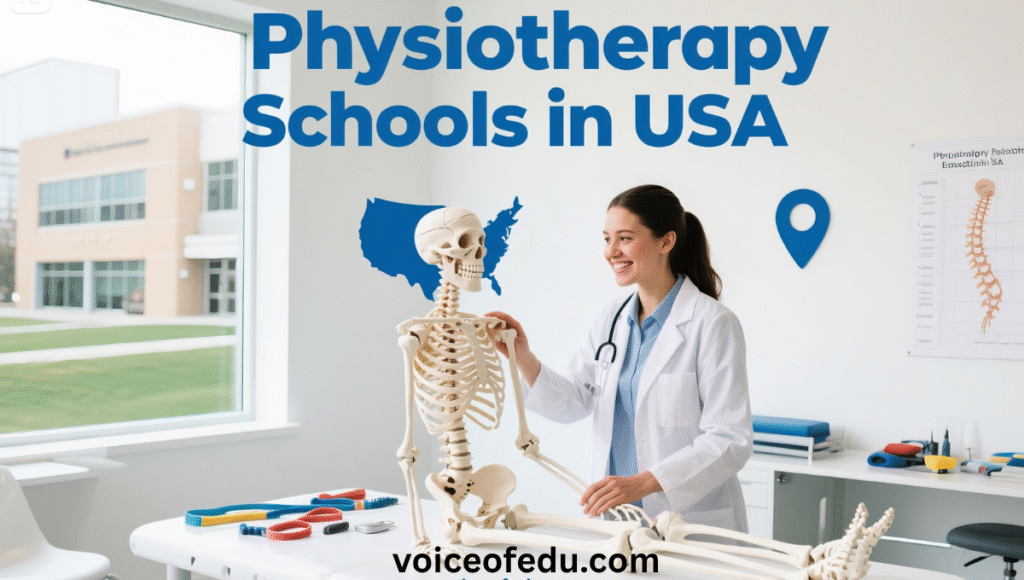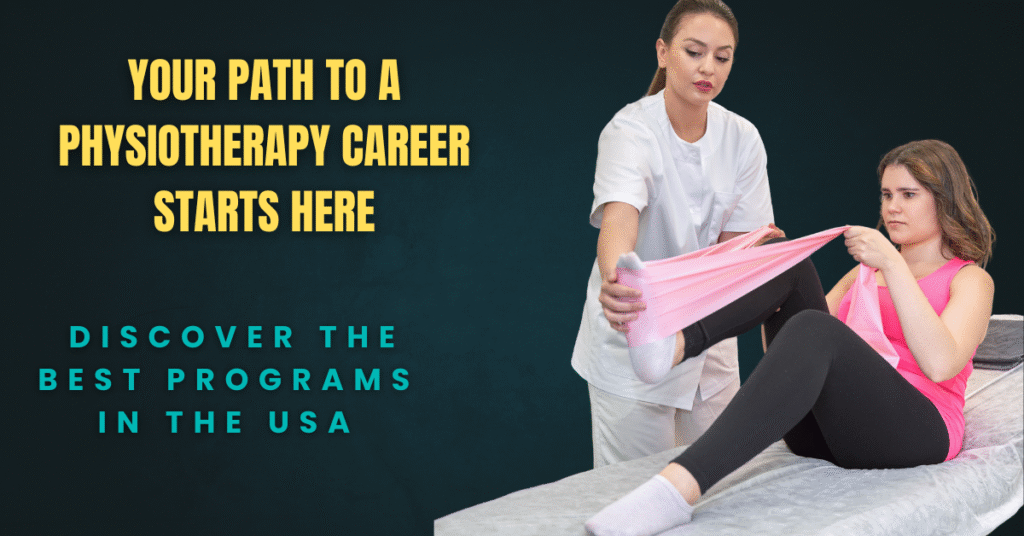Physiotherapy, also called physical therapy, is a vital healthcare profession dedicated to restoring movement and function in individuals affected by injury, illness, or disability. As the demand for qualified physical therapists grows across the United States, prospective students are eager to find the best physiotherapy schools in the USA to launch their careers effectively.
This comprehensive guide provides detailed information on top physiotherapy schools in the U.S., covering program options, admission prerequisites, tuition considerations, clinical training, career prospects, and more. Whether you are a recent high school graduate, a working professional considering a career change, or an international student, this guide will help you make well-informed decisions to achieve your goals.
How to Choose the Best Physiotherapy School in the U.S.
Selecting the right school is crucial for your education, licensure, and professional opportunities. Consider these key factors carefully:
1. Accreditation
Only attend programs accredited by the Commission on Accreditation in Physical Therapy Education (CAPTE). This accreditation ensures the program meets national educational standards. Graduates of CAPTE-accredited programs are eligible for physical therapy licensure in all U.S. states.
2. Program Offerings
Look for schools that offer the Doctor of Physical Therapy (DPT) degree, which is now the required credential for professional practice in the U.S. Some institutions also offer transitional DPT programs, tailored for licensed physical therapists who hold bachelor’s or master’s degrees and wish to upgrade their qualifications.
3. Clinical Training Opportunities
Hands-on clinical experience is essential. Choose programs that maintain partnerships with hospitals, outpatient clinics, rehab centers, and other healthcare facilities. Robust clinical rotations provide real-world training and help build professional networks.
4. Faculty Expertise
Experienced faculty with active clinical and research roles can greatly enrich your learning. Look for schools with professors and instructors who mentor students and bring current, evidence-based practices into the classroom.
5. Location and Facilities
Consider schools with updated facilities that support advanced learning technologies. The school’s location affects living costs and access to clinical sites, as well as potential job connections in local healthcare communities.
6. Program Outcomes
Evaluate graduation rates, pass rates for the National Physical Therapy Examination (NPTE), and job placement statistics. Strong outcome data indicates program effectiveness and employer confidence in graduates.
7. Cost and Financial Aid
Tuition, fees, and living expenses vary widely. Some schools offer scholarships, grants, and assistantship opportunities to reduce financial burdens. Explore all aid options and budget accordingly.
8. Flexibility
Many schools now offer online or hybrid courses for theoretical components, providing flexibility to working students. However, clinical skills remain in-person due to hands-on requirements. These blended formats help balance education with life commitments.
List of 20 Top Physiotherapy Schools in the USA with Specialties
| School Name | Location | Specialty Focus |
|---|---|---|
| University of Southern California | Los Angeles, CA | Neurological and Orthopedic PT |
| University of Pittsburgh | Pittsburgh, PA | Sports Physical Therapy |
| University of Iowa | Iowa City, IA | Pediatric and Geriatric PT |
| Washington University in St. Louis | St. Louis, MO | Cardiopulmonary Rehabilitation |
| University of Delaware | Newark, DE | Manual Therapy |
| MGH Institute of Health Professions | Boston, MA | Oncology Rehabilitation |
| Emory University | Atlanta, GA | Neuromuscular Disorders |
| University of Miami | Coral Gables, FL | Musculoskeletal PT |
| University of Minnesota | Minneapolis, MN | Pediatric and Neurological PT |
| University of North Carolina | Chapel Hill, NC | Orthopedics and Sports |
| Northeastern University | Boston, MA | Cardiopulmonary and Geriatrics |
| Duke University | Durham, NC | Orthopedic Manual Therapy |
| Northwestern University | Chicago, IL | Neurological Rehabilitation |
| University of Washington | Seattle, WA | Acute Care and Critical Illness |
| Boston University | Boston, MA | Musculoskeletal and Sports PT |
| Ohio State University | Columbus, OH | Rehabilitation Science |
| University of Florida | Gainesville, FL | Pediatric Physical Therapy |
| University of Maryland | Baltimore, MD | Neurorehabilitation |
| Texas Woman’s University | Denton, TX | Women’s Health Physical Therapy |
| University of Colorado | Denver, CO | Orthopedic and Sports PT |
Accredited DPT Programs vs. Other Physiotherapy Degrees: What’s Right for You?
- Bachelor’s Degrees: Usually in kinesiology or exercise science, serving as preparatory education, but insufficient alone for licensure.
- Master’s Degree Programs: Previously common, now largely replaced by DPT for initial licensure.
- Transitional DPT Programs: Designed for practicing therapists with bachelor’s or master’s to earn the DPT credential.
Why Choose a CAPTE-Accredited DPT Program?
- Meets licensure requirements in all U.S. states.
- Graduates qualify to take the National Physical Therapy Examination (NPTE).
- Accredited programs have better job placement rates and salary prospects.
- Offer extensive research and clinical training opportunities.
What to Expect in DPT Programs
- Curriculum: In-depth courses in human anatomy, biomechanics, neuroscience, pathology, and clinical practice.
- Clinical Rotations: Hands-on patient care in diverse healthcare settings including hospitals, rehab centers, and outpatient clinics.
- Program Length: Typically three years of full-time study.
- Some schools may offer hybrid formats combining online lectures with in-person clinical skills training.

What to Look for in a Top-Ranked Physiotherapy Program
Key factors to evaluate include:
| Factor | Description |
|---|---|
| Accreditation | CAPTE accreditation is mandatory for licensure. |
| Faculty Qualifications | Experienced faculty with research and clinical expertise. |
| Clinical Partnerships | Access to varied clinical environments for rotations. |
| Program Outcomes | High NPTE pass rates, graduation, and employment rates. |
| Curriculum | Comprehensive and updated courses in therapy science. |
| Research Opportunities | Support for evidence-based practice and innovation. |
| Student Support | Advising, tutoring, mental health, and career counseling available. |
Common Admission Requirements for DPT Programs
- Bachelor’s degree from an accredited institution with completed science prerequisites.
- Prerequisites typically include biology, chemistry, physics, anatomy, and physiology.
- Minimum GPA usually around 3.0, with some programs requiring higher science GPAs.
- GRE scores may be required by some schools, though many have waived this recently.
- Letters of recommendation from academic or professional references.
- 50 to 100 hours of observation or shadowing licensed physical therapists.
- Personal statement articulating motivation and career goals.
- Interview to assess interpersonal skills and program fit.
Online and Hybrid Physical Therapy Programs
While clinical skills must be acquired in person, many schools offer theoretical coursework online or in hybrid formats to help working students or those with other commitments. Examples include Chatham University, Arcadia University, and the University of St. Augustine.
Minimum GPA and Test Scores
Most competitive DPT programs require a minimum overall GPA around 3.0, with science GPAs needing to be slightly higher. GRE scores generally range from 300 to 310, though some programs have flexible or no GRE requirements currently.
Understanding CAPTE Accreditation
The Commission on Accreditation in Physical Therapy Education (CAPTE) is the sole accrediting body for physical therapy education in the U.S. CAPTE accreditation certifies that programs meet rigorous academic, clinical, and facility standards. Only graduates from these programs may take the NPTE, the national licensure exam.
Timeline: From Application to Enrollment
- Start prerequisite courses and observation hours 12 to 18 months before enrollment.
- Prepare and take the GRE 9 to 12 months before applying (if required).
- Submit applications through the Physical Therapist Centralized Application Service (PTCAS) 6 to 9 months ahead.
- Attend interviews and accept offers 3 to 6 months in advance.
- Finalize financial aid, housing, and registration 1 to 3 months before starting.
Licensure Requirements Across States
All U.S. states and territories require physical therapists to have licensure. Licensure requires passing the NPTE, fulfilling education criteria, and often a jurisprudence exam. Some states require background checks or continuing education for renewal.
International Students in U.S. Physiotherapy Programs
Many programs welcome international students. They typically require credential verification and proof of English proficiency through TOEFL or IELTS. F-1 student visas sponsor international enrollment, requiring full-time study.
Clinical Training Overview
DPT programs typically include 30 to 40 weeks of clinical rotations covering diverse patient populations and specialties like inpatient, outpatient, pediatrics, geriatrics, neurology, orthopedics, and cardiopulmonary rehabilitation. These supervised rotations develop clinical reasoning and practical skills.
Scholarships for Physical Therapy Students
Scholarships help reduce program costs and may be offered by:
- The American Physical Therapy Association (APTA)
- Individual universities based on merit or need
- Private foundations targeting underrepresented groups
Part-Time or Evening DPT Programs
Most physical therapy programs are full-time due to extensive clinical components. Limited hybrid or bridge programs offer more flexibility. Some part-time options exist for post-professional education or continuing education.
GRE Requirements
While historically required, many schools have waived the GRE recently. Always check program-specific policies before applying.
Visa Requirements for International Students
An F-1 student visa is generally required. Schools issue I-20 forms for visa applications. Students must maintain full-time status to keep visa eligibility.
Accelerated DPT Programs
Some schools offer accelerated tracks of 2.5 years, suitable for students with prior healthcare training. These involve intensive study schedules.
Preparing for PT School Interviews
Practice common questions on motivation, teamwork, and ethics. Highlight clinical experience and communication skills. Dress professionally and arrive punctually.
Bridging Programs for Foreign-Trained Physiotherapists
Some U.S. programs offer transitional DPT courses for internationally trained PTs to meet licensure requirements and update skills.
Practicing with a Non-U.S. PT Degree
Graduates must pass ECFMG certification and the NPTE. Credential evaluation and clinical competency assessments are usually required.
FAQs
How long does it take to become a physiotherapist in the USA?
Usually about 7 years: four undergraduate years plus three years in a DPT program including clinical training.
Which universities are best for physiotherapy?
Top-ranked schools include University of Southern California, University of Pittsburgh, University of Iowa, and Washington University in St. Louis.
What is the top physical therapy school in the U.S.?
University of Southern California is often ranked as the leading program nationwide.
How long is physical therapy school?
Most full-time DPT programs require three years to complete.
Choosing the right physiotherapy school with accredited programs, quality faculty, and excellent clinical experiences sets a strong foundation for your career. With growing opportunities in healthcare, pursuing a DPT from a reputable U.S. institution ensures you’re prepared to make a meaningful difference in patients’ lives while building a rewarding profession.

